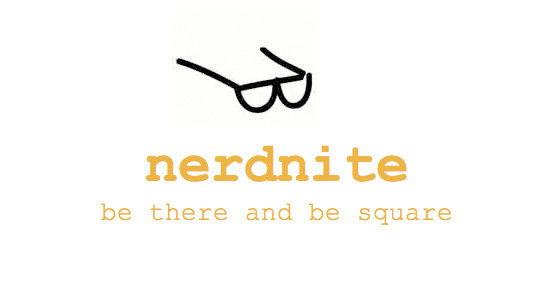At SDCC, you might think that every night is Nerd Nite, but Nerd Nite is a movement that has captured bar-going nerds, and their motto is “Be there and be square.” What can be more square or at least nearly square as a company whose logo is a yellow rectangle like National Geographic? For SDCC, National Geographic and their Emmy-nominated series “Brain Games” teamed up with the San Diego Nerd Nite people for a special edition of nerdiness, and what were the nerds talking about but “The Science of ‘Jurassic World.'”
Held at the Silo in Makers Quarter, the Nerd Nite venue was not a bar, but a pale dirt lot large enough for two food trucks and a makeshift bar and a few wooden tables set out along with rows of folding chairs before a large screen. The venue is dusty but danceable.
Once there, you might have to justify your nerdiness. Instead of your zodiac sign or whatever makes a good ice breaker now at bars, you’ll be asked for your nerd credentials.
Even if you’ve been away from college for a while, be ready to state your major, university and degree pedigree. For us, that’s a fairly easy pass, but be sure to ask if the person doesn’t have a master’s if he/she went straight on for a PhD. There are still ringers for this less exclusive version of Mensa socials.
One of the three guest lecturers for the night was from Los Angeles, paleontologist Trevor Valle, who was previously with the George C. Page Museum at the La Brea Tar Pits in Los Angeles and is currently with SWCA Environmental Consultants and Applied EarthWorks, Inc.
Elsewhere I have written about what Mike Habib of the Natural History Museum of Los Angeles thought of “Jurassic World” and Valle basically agrees with Habib. His slideshow presentation emphasized just how much size matters such as the size of an actual velociraptor (Velociraptor mongoliensis). They were only 1.6 feet high and 6.8 feet long, including the tail. At about 33 lbs., they were the size of a border collie or a very large and angry turkey.
In “Jurassic World,” however, the velociraptor is bigger than its cousin Deinonychus antirrhopus or about the size of the Utahraptor ostrommaysorum. Valle theorized that the name velociraptor won out, perhaps due to the name having more perceived coolness. Sorry, Utahraptor and the state of Utah. You need better PR.
The other size debate has to do with a non-dinosaur, the mosasaurus. Valle found the beast to be much larger than the largest known example. Just how big varies, especially depending upon whether you’re using the announcer or the shark as the basis for your calculations. Yes, calculations have been made by nerds all over the Internet.
There is one online defense of the mosasaurus in “Jurassic World,” yet there is no defense for the featherless T-rex and velociraptor. That’s something that most dinosaur experts agree upon. In the “Jurassic Park” movie series, the depictions of the dinosaurs have remained the same since the first movie in 1993, but paleontologists have changed their concepts of the physical appearance of the creatures since then.
In order to be ready for the mad SDCC dash Saturday morning, we retired before the results of the Brain Games contest and the presentations “Shop Class 2.0,” by Joan Horvath and Rich “Whosawhatsis” Cameron, co-founders of Maker Technology Consultancy Nonscriptum LLC; and “Dead Life: Making a Living in Taxidermy,” by award-winning taxidermist Allis Markham.
Nerd Nite is an event held a public venue or bar where someone gives a short lecture about a topic most nerdy or at least nerdish while the crowd drinks. There might even be a bit of trivial pursuit type competitions. Nerd Nite began in 2003 with a grad student named Chris Balakrishan in Boston, and from there it went to New York and eventually spread to 80 cities worldwide. From the graphic shown on Friday evening, not all 50 states and cities have enough drinking nerds to have Nerd Nites, but San Diego does.
National Geographic’s “Brain Games” debuted as a special in 2011 and returned as a regular series in 2013. Currently “Brain Games” is in its fifth season. Episodes can be found online on the National Geographic TV website.












